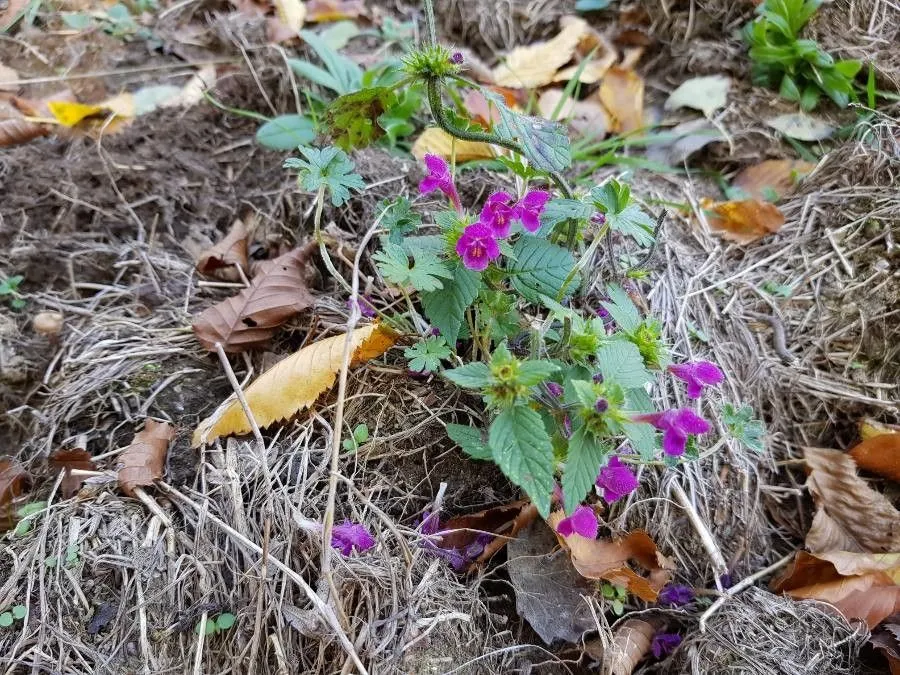
Author: L.
Bibliography: Sp. Pl.: 579 (1753)
Year: 1753
Status: accepted
Rank: species
Genus: Galeopsis
Vegetable: False
Observations: Europe to SW. Siberia
The Common hemp-nettle, scientifically known as Galeopsis tetrahit, is a notable member of the Lamiaceae family. First described in 1753 by the renowned botanist Carl Linnaeus, this plant has secured its place in botanical literature through Linnaeus’s seminal work “Species Plantarum”.
Widely distributed across Europe and extending into Southwestern Siberia, Galeopsis tetrahit thrives in a variety of habitats ranging from woodlands to disturbed areas such as roadsides and agricultural fields. The plant typically reaches a height of 30-100 cm and is characterized by its square stems, common to many in the mint family. These stems can often present swollen nodes, a distinguishing feature of the species.
The foliage of Common hemp-nettle consists of opposite, serrated leaves that are particularly adept at photosynthesis, supporting the plant’s rapid growth. Flowering predominantly occurs in the summer months, heralding a display of tubular, two-lipped flowers. These blossoms are usually pale pink, purple, or even white, and are arranged in dense whorls at the axils of the upper leaves and stem tips.
Ecologically, Galeopsis tetrahit serves as a valuable source of nectar for various pollinators, including bees and butterflies, which play a crucial role in the reproductive cycle of many plant species within its native range. Additionally, its somewhat bristly texture and robust form enable it to outcompete other plants in its preferred environments, thereby often dominating the plant communities where it establishes itself.
As part of the Lamiaceae family, Common hemp-nettle shares several key characteristics with other members of this group, including aromatic qualities, although less pronounced in this species compared to well-known relatives like mint and basil. Despite its common name, it is not directly related to the true hemp plant (Cannabis sativa), but the resemblance in leaf shape led to the shared vernacular name.
In historical herbalism, Galeopsis tetrahit was occasionally utilized for its believed medicinal properties, although modern usage has waned with the advent of more effective treatments. This plant’s history of use and its ecological role illustrate the interconnectedness between human culture and the natural world, preserving its significance in both botanical and cultural contexts.
Through its widespread presence and distinct characteristics, the Common hemp-nettle continues to be a subject of interest for botanists and ecologists, highlighting the diverse tapestry of plant life that occupies Europe and Southwestern Siberia.
Dan: almindelig hanekro
Eng: brittlestem hempnettle, common hemp-nettle, hemp-nettle, brittle-stemmed hemp-nettle, dog nettle, ironwort
Deu: gemeiner hohlzahn, gewöhnlicher hohlzahn
Fra: galéopsis tétrahit, galéopside à tige carrée, ortie royale
Nld: gewone hennepnetel
Fin: karheapillike
Swe: karheapillike, pipdån
Nno: kvassdå
Nob: kvassdå
Sme: biipogárremas
Cym: cymalau’r diafol, danhadlen y cywarch, penboeth, penboeth cyffredin, y benboeth
En: Common hemp-nettle, Hemp-nettle, Brittlestem hempnettle, Brittle-stemmed hemp-nettle, Dog nettle, Ironwort, Bristle-stem Hemp-nettle, Common Hempnettle
Cs: Konopnice polní
Da: Almindelig hanekro
Nl: Gewone hennepnetel
Fi: Karheapillike
Fr: Galéopsis tétrahit, Galéopside à tige carrée, Ortie royale, Chanvre bâtard, Herbe de Hongrie, Ortie épineuse
De: Gemeiner Hohlzahn, Gewöhnlicher Hohlzahn, Hanfnessel, Stechender Hohlzahn
It: Canapa selvatica, Canapetta comune
Se: Biipogárremas
Nb: Kvassdå
Nn: Kvassdå
Pt-br: Galeópse-comum
Sk: Konopnica napuchnutá
Es: Ortiga real
Sv: Pipdån, Karheapillike
Cy: Cymalau’r Diafol, Danhadlen y Cywarch, Penboeth, Penboeth Cyffredin, Y Benboeth
Taken Sep 11, 2018 by Pep Secem (cc-by-sa)
Taken Sep 11, 2018 by Pep Secem (cc-by-sa)
Taken Sep 11, 2018 by Pep Secem (cc-by-sa)
Taken Sep 11, 2018 by Pep Secem (cc-by-sa)
Taken Sep 11, 2018 by Pep Secem (cc-by-sa)
Taken Sep 23, 2018 by 1 (cc-by-sa)
Taken Sep 11, 2018 by Pep Secem (cc-by-sa)
Taken Sep 11, 2018 by Pep Secem (cc-by-sa)
Taken Sep 11, 2018 by Pep Secem (cc-by-sa)
Taken Sep 11, 2018 by Pep Secem (cc-by-sa)
Taken Oct 20, 2019 by Marlu (cc-by-sa)
Taken Sep 23, 2018 by 1 (cc-by-sa)
Taken Sep 23, 2018 by 1 (cc-by-sa)
Taken Sep 11, 2018 by Pep Secem (cc-by-sa)
Taken Sep 11, 2018 by Pep Secem (cc-by-sa)
Taken Oct 17, 2021 by Maarten Vanhove (cc-by-sa)
Taken Aug 29, 2021 by 🐞Hélène🐦 (cc-by-sa)
Taken Sep 19, 2018 by 1 (cc-by-sa)
Taken Sep 11, 2018 by Pep Secem (cc-by-sa)
Taken Sep 11, 2018 by Pep Secem (cc-by-sa)
Taken Aug 9, 2021 by Frozy
Taken Aug 17, 2021 by Jacques Zuber (cc-by-sa)
Taken Sep 24, 2022 by Kai Best (cc-by-sa)
Taken Sep 24, 2022 by Kai Best (cc-by-sa)
Taken Oct 13, 2019 by Ivana Prusova (cc-by-sa)
Taken Aug 22, 2021 by High Treeson (cc-by-sa)
Taken Dec 1, 2020 by jonathan tamaillon (cc-by-sa)
Taken Aug 28, 2021 by Steve Orridge (cc-by-sa)
Taken Jul 31, 2019 by René Burkhard (cc-by-sa)
Taken Aug 21, 2021 by High Treeson (cc-by-sa)
© copyright of the Board of Trustees of the Royal Botanic Gardens, Kew.
© copyright of the Board of Trustees of the Royal Botanic Gardens, Kew.
© copyright of the Board of Trustees of the Royal Botanic Gardens, Kew.
Growth habit: Forb/herb
Ph maximum: 6.5
Ph minimum: 5.5
Light: 5
Atmospheric humidity: 5
Bloom months: [‘jul’, ‘aug’, ‘sep’, ‘oct’]
Soil nutriments: 7
Family: Myrtaceae Author: (F.Muell.) K.D.Hill & L.A.S.Johnson Bibliography: Telopea 6: 402 (1995) Year: 1995 Status:…
Family: Rubiaceae Author: Pierre ex A.Froehner Bibliography: Notizbl. Bot. Gart. Berlin-Dahlem 1: 237 (1897) Year:…
Family: Sapindaceae Author: Koidz. Bibliography: J. Coll. Sci. Imp. Univ. Tokyo 32(1): 38 (1911) Year:…
Family: Asteraceae Author: A.Gray Bibliography: Pacif. Railr. Rep.: 107 (1857) Year: 1857 Status: accepted Rank:…
Family: Fabaceae Author: Medik. Bibliography: Vorles. Churpfälz. Phys.-Ökon. Ges. 2: 398 (1787) Year: 1787 Status:…
Family: Aspleniaceae Author: (Cav.) Alston Bibliography: Bull. Misc. Inform. Kew 1932: 309 (1932) Year: 1932…